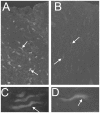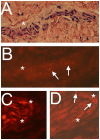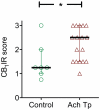Increased expression of cannabinoid CB₁ receptors in Achilles tendinosis
- PMID: 21931835
- PMCID: PMC3169627
- DOI: 10.1371/journal.pone.0024731
Increased expression of cannabinoid CB₁ receptors in Achilles tendinosis
Abstract
Background: The endogenous cannabinoid system is involved in the control of pain. However, little is known as to the integrity of the cannabinoid system in human pain syndromes. Here we investigate the expression of the cannabinoid receptor 1 (CB₁) in human Achilles tendons from healthy volunteers and from patients with Achilles tendinosis.
Methodology: Cannabinoid CB₁ receptor immunoreactivity (CB₁IR) was evaluated in formalin-fixed biopsies from individuals suffering from painful Achilles tendinosis in comparison with healthy human Achilles tendons.
Principal findings: CB₁IR was seen as a granular pattern in the tenocytes. CB₁IR was also observed in the blood vessel wall and in the perineurium of the nerve. Quantification of the immunoreactivity in tenocytes showed an increase of CB₁ receptor expression in tendinosis tissue compared to control tissue.
Conclusion: Expression of cannabinoid receptor 1 is increased in human Achilles tendinosis suggesting that the cannabinoid system may be dysregulated in this disorder.
Conflict of interest statement
Figures




Similar articles
-
Presence of a non-neuronal cholinergic system and occurrence of up- and down-regulation in expression of M2 muscarinic acetylcholine receptors: new aspects of importance regarding Achilles tendon tendinosis (tendinopathy).Cell Tissue Res. 2008 Feb;331(2):385-400. doi: 10.1007/s00441-007-0524-1. Epub 2007 Nov 13. Cell Tissue Res. 2008. PMID: 17999088
-
VGluT2 expression in painful Achilles and patellar tendinosis: evidence of local glutamate release by tenocytes.J Orthop Res. 2008 May;26(5):685-92. doi: 10.1002/jor.20536. J Orthop Res. 2008. PMID: 18050306 Free PMC article.
-
Evidence of the TNF-α system in the human Achilles tendon: expression of TNF-α and TNF receptor at both protein and mRNA levels in the tenocytes.Cells Tissues Organs. 2012;196(4):339-52. doi: 10.1159/000335475. Epub 2012 May 8. Cells Tissues Organs. 2012. PMID: 22572155
-
Achilles Tendinosis Injuries-Tendinosis to Rupture (Getting the Athlete Back to Play).Clin Sports Med. 2020 Oct;39(4):877-891. doi: 10.1016/j.csm.2020.05.001. Epub 2020 Aug 14. Clin Sports Med. 2020. PMID: 32892973 Review.
-
Noninsertional Tendinopathy of the Achilles.Foot Ankle Clin. 2017 Dec;22(4):745-760. doi: 10.1016/j.fcl.2017.07.006. Epub 2017 Sep 28. Foot Ankle Clin. 2017. PMID: 29078826 Review.
Cited by
-
Monoacylglycerol lipase - a target for drug development?Br J Pharmacol. 2012 Jul;166(5):1568-85. doi: 10.1111/j.1476-5381.2012.01950.x. Br J Pharmacol. 2012. PMID: 22428756 Free PMC article. Review.
-
Novel insights into the pathogenesis of tendon injury: mechanotransduction and neuroplasticity.Neural Regen Res. 2022 Oct;17(10):2223-2224. doi: 10.4103/1673-5374.335802. Neural Regen Res. 2022. PMID: 35259839 Free PMC article. No abstract available.
-
Do Mast Cells Have a Role in Tendon Healing and Inflammation?Cells. 2020 May 4;9(5):1134. doi: 10.3390/cells9051134. Cells. 2020. PMID: 32375419 Free PMC article. Review.
-
Proteomics perspectives in rotator cuff research: a systematic review of gene expression and protein composition in human tendinopathy.PLoS One. 2015 Apr 16;10(4):e0119974. doi: 10.1371/journal.pone.0119974. eCollection 2015. PLoS One. 2015. PMID: 25879758 Free PMC article.
-
The peripheral neuronal phenotype is important in the pathogenesis of painful human tendinopathy: a systematic review.Clin Orthop Relat Res. 2013 Sep;471(9):3036-46. doi: 10.1007/s11999-013-3010-y. Epub 2013 Apr 23. Clin Orthop Relat Res. 2013. PMID: 23609815 Free PMC article.
References
-
- Reynolds J. On the therapeutical uses and toxic effects of cannabis indica. Lancet. 1890;135:637–638.
-
- Maida V, Ennis, Irani S, Corbo M, Dolzhykov M. Adjunctive nabilone in cancer pain and symptom management: a prospective observational study using propensity scoring. J Support Oncol. 2008;6:119–124. - PubMed
-
- Skrabek RQ, Galimova L, Ethans K, Perry D. Nabilone for the treatment of pain in fibromyalgia. J Pain. 2008;9:164–173. - PubMed
Publication types
MeSH terms
Substances
LinkOut - more resources
Full Text Sources
Medical

